

| Circe
| Tuesday, January 26, 2010 One of the items we'd identified during yesterday's dodger session was that the rope groove track at the leading edge of the dodger base might have an effect on the placement of the aft-leading halyards and control lines, thanks to the vertical height of the track (about 5/8"). To that end, it looked like I'd have to place the forward deck organizer (3-sheave) and rope clutch on slightly raised platforms to improve clearance for the lines. From scrap plywood, I made up some 1/2" thick mockup bases for the two hardware items, and temporarily secured them to the deck with tape, along with three lengths of line to illustrate how and where the lines would pass through the dodger on their way aft. I arranged the deck organizer so that all the lines would run aft parallel to the sea hood. The 1/2" height increase would be fine, so I'd make up some permanent spacers and prepare them in time for the final hardware installation in the coming weeks. |
|
Another clearance concern was the halyard winches and handles: the dodger frame appeared to pose a possible clearance problem, which is certainly common in these installations. Fortunately, I determined that an 8" winch handle would clear the dodger frame with the winch in its proposed location; I had room to cheat the winch inboard towards the hatch a little if need be as well. These photos show an old 12" winch handle that I had on hand, but the tape demarks the 8" length that's salient to the layout here. |
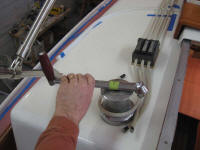 |
|
Seth wasn't due back till noontime or so, so I spent the rest of the morning making a variety of measurements inside the boat to determine rough sizes and quantities of stock for trim and cabinet doors. With these lists in hand, I rough-cut a variety of pieces that I'd later turn into the lengths and shapes required. I also started working on a list of some additional wood I'd need to complete the interior, particularly for the cabin sole, which we determined would be mahogany, and also additional cherry for the wooden ceilings in the main cabin. |
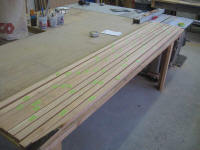
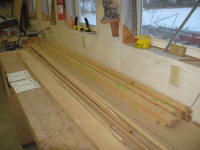 |
|
Once Seth arrived, I focused on the templating process, with the myriad decisions required along the way. Over the course of the afternoon, the shape of the new dodger, represented in translucent patterning plastic, came to life. This dodger would feature an opening front horseshoe window for ventilation, removable side wings, rear grab rail, and internal bracing to hold the dodger upright when the wings were removed, among other features. Where the dodger would come off the curved deck track and down onto the side of the cabin trunk as it began its transition aft to the wings and around the protruding coamings, Seth patterned a shape that would follow the curve of the deadlight frames, which curve would also be replicated (to the extent possible) in the aft shape of the main window. There'd be additional windows in the dodger wings, as well as the usual triangular window in the space between the frame bows. The shape and placement of these windows is not necessarily clear (or even marked) on the template, but we discussed all these details throughout the process. |
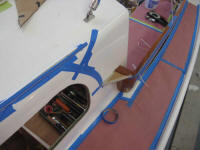
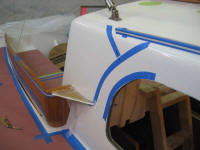
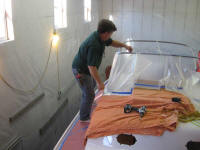 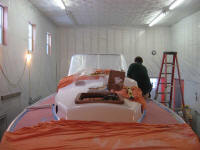
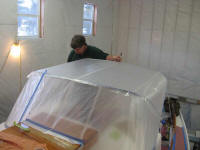
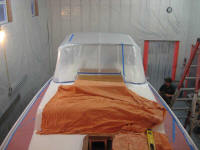 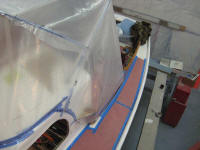
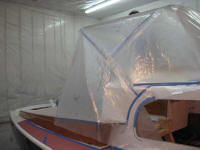
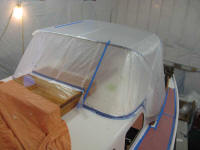 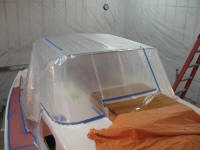
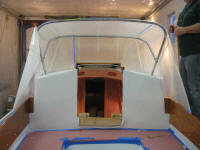
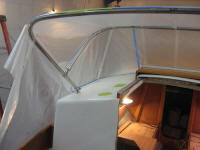 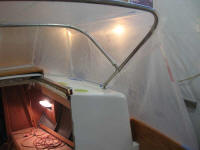
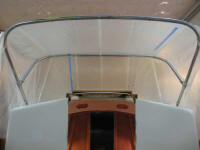 |
|
For the aft-leading halyards, Seth would build a slot--an inch wider than the space consumed by the lines themselves--in the dodger front just above the track. a couple inches outboard of the side of the sea hood. |
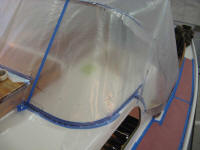 |
|
In the profile views of the template, note that the aft edge of the dodger wing is defined not by the shape of the pattern plastic, but by the position of the strip of tape extending between the coaming and the dodger frame, just below the curve of the aft bow. |
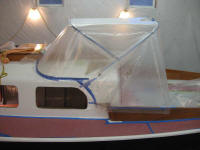
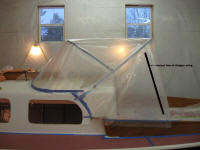 |
|
With the dodger template finally complete, we moved below to discuss the interior cushions and filler pieces, after which Seth made the requisite patterns. The severe bevel formed by the hull at the aft end of the starboard berth posed a challenge for the cushion makers, but I had faith in their ability to make it happen. What fun is it to make boring rectangular cushions, anyway? A little challenge is always good. |
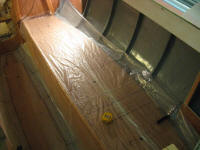
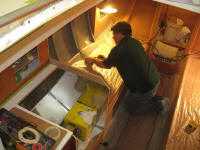 |
|
I made some minor modifications to the plywood filler pieces for the convertible double berth based on Seth's requests. These filler cushions would be permanently secured to their plywood backing for ease of storage and deployment, and to that end I rounded the corners of the panels so the fabric and foam could curve around appropriately. With that, the template process was complete. As of this writing, color and fabric selections were pending and under consideration, but the cushions and dodger would likely be complete within a few weeks' time. |
|